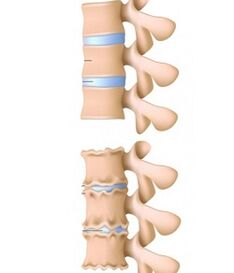
What are the causes of cervical osteochondrosis? What are the symptoms? How to effectively treat cervical spine osteochondrosis at home?
Cervical osteochondrosis is one of the most common diseases affecting young people (25-40 years). The development of cervical osteochondrosis is facilitated by staying in the wrong, tense position for a long time - for example, the habit of working on a computer during the day or supporting the phone receiver with your shoulder.
It is often caused by prolonged exposure to vibration, as when working with construction equipment or driving a car. In addition, incorrect posture, restless bed, sedentary lifestyle, hereditary predisposition and other factors can cause cervical osteochondrosis.
Cervical osteochondrosis and its causes
Cervical osteochondrosis is a degenerative-dystrophic lesion of the intervertebral disc in the cervical spine. This occurs against the background of metabolic diseases of the cervical spine, in which the intervertebral discs (special spaces between the vertebrae) and the vertebral bodies themselves change.
Cervical osteochondrosis is slightly different in symptoms from osteochondrosis of other parts. This is the most dangerous type of osteochondrosis, as it often disrupts the nerve root that runs from the spinal cord and disrupts the blood supply to the brain due to the constriction of blood vessels. The reason is the features of the anatomical structure of the spine in the cervical region. Thus, one of the large arteries that feeds the brain - the vertebral - passes precisely through the open areas of the cervical vertebral processes. Therefore, the pathological changes in them - the proliferation of bone and fibrous tissue, the displacement of the vertebrae - lead to a violation of the normal functioning of this artery.
In addition, the structure of the cervical spine is slightly different - the vertebrae are closer to each other. Therefore, with any, even insignificant pathological change in one of the vertebrae, the normal functioning of the whole part is disrupted - depression or displacement of nerves and blood vessels, the spinal cord is compressed more often than in the spine or thorax. osteochondrosis. As a result, a significant dysfunction can be observed with cervical osteochondrosis - sensitivity of the skin and attacks of the neck, face, arm muscles, dizziness. Noise or ringing in the ears and head, constant headaches, increased fatigue, blurred vision and hearing, instability while walking, etc.
Symptoms of cervical osteochondrosis

Among the symptoms of cervical osteochondrosis are:
- Pain in the neck, back of the head, shoulder or arm. In addition, there is weakness in the arm muscles, difficulty in head movements, and a crisis in the neck when turning or tilting the head.
- Often there is a pulling pain that spreads to the left arm on the left side of the chest. There may be a burning sensation or pain between the shoulder blades.
- Cervical osteochondrosis causes recurrent headaches, a feeling of weakness and increased fatigue. As a rule, the pain is painful in nature and is concentrated on the side and back of the neck, as well as on the back of the head. Patients often have difficulty moving their head, especially when turning in different directions.
- Neck pain can spread to the arm and extend from the shoulder to the fingers with numbness. In this condition, patients sometimes complain of "itching" or "electric shock" along the arms and legs when bending the neck.
- Cervical osteochondrosis can also cause hearing and vision impairment, pain in the hands, heart and lung problems, dizziness, nausea, double vision, and numbness of the face and tongue.
What is cervical osteochondrosis? What are the symptoms? How is cervical osteochondrosis treated?
Treatment of cervical osteochondrosis
As a rule, cervical osteochondrosis begins in a mild form and does not cause any discomfort to the person at first. At this stage, medical treatment is not required at all, it is only enough to prevent further complications, improve working conditions and change the lifestyle in favor of a healthier one.
To prevent cervical osteochondrosis, you should lead an active lifestyle, exercise in the morning, follow a moderate calorie diet, get rid of bad habits and avoid heavy lifting. Proper posture, proper posture while sitting and lying down, and a comfortable bed are also important factors in prevention. Therapeutic gymnastics courses will also be useful.
However, with age, cervical osteochondrosis develops and can progress to more serious forms. In this case, cervical osteochondrosis is treated conservatively. These include: wearing a special collar, physiotherapy, exercise therapy, massage. In more severe cases, the patient may require medication - analgesics, antispasmodics, non-steroidal anti-inflammatory drugs (NSAIDs). Physiotherapeutic procedures are also prescribed (paraffin, drug electrophoresis, etc. ).
Chondroprotectors are indicated for the treatment of chronic osteochondrosis of the cervical spine in addition to B vitamins (B6, B12). Medications for external use are widely used - ointments, creams, gels with NSAIDs, local irritants and tissue regeneration stimulants.
Recently, a new drug has emerged in pharmacies that can seriously help in the treatment of cervical osteochondrosis - a therapeutic analgesic anti-inflammatory patch.
Medical plaster treatment of cervical osteochondrosis
Various substances such as NSAIDs, analgesics, antispasmodics are used in the therapeutic treatment of cervical osteochondrosis. All of these funds are effective, but with long-term use can harm the body. Therefore, it is very important to minimize side effects and increase the effectiveness of treatment. Anesthetic anti-inflammatory medical patch - a new generation drug - can help.
The healing patch is very effective, eliminates pain and inflammation, improves blood circulation in the affected area and reduces the dose of painkillers and anti-inflammatory drugs.
In the treatment of cervical osteochondrosis, a medical surface is applied to the affected area of the neck, away from the anterior surface, especially the carotid arteries and lymph nodes. A course of treatment of 9 days or more is recommended. It is recommended to use the patch at 12 o'clock in the morning, but it is possible to apply at night.
High efficiency, specificity of the composition, long-term therapeutic effect, ease of use and reasonable price make the drug patch the tool of choice in the treatment of cervical osteochondrosis.






















